Scene 1 (2:57-4:30): The True Story of a Real Fake
Welcome to the Steal!
“Catch Me If You Can”
is the story of
Frank Abagnale,
who was widely recognized as the best
con artist,
check forger,
impostor
and
escape artist
in American history.
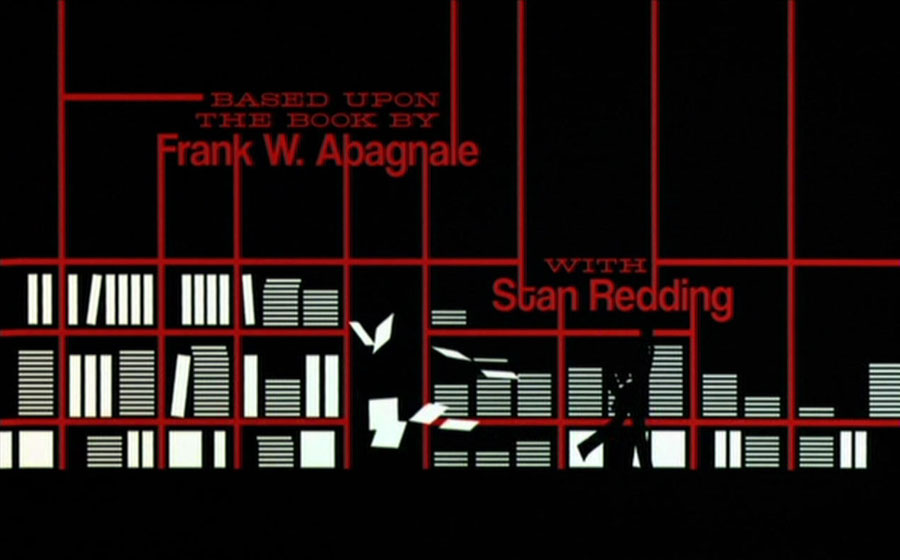
Scene 1 — 2:00
As his identity was unknown for a long
period of time, the
“unsub”
(an “unknown subject” in
F.B.I.
speak, also called a
“John Doe”)
was called the
“Skywayman”
by the law and the press, because of his
posing as an
airline pilot.
(In scene 11, Abagnale meets a
Pan Am
P.R.
guy. He’s nervous, jumpy because
there’s another piece about the
“Skywayman” in the New York
Times...)
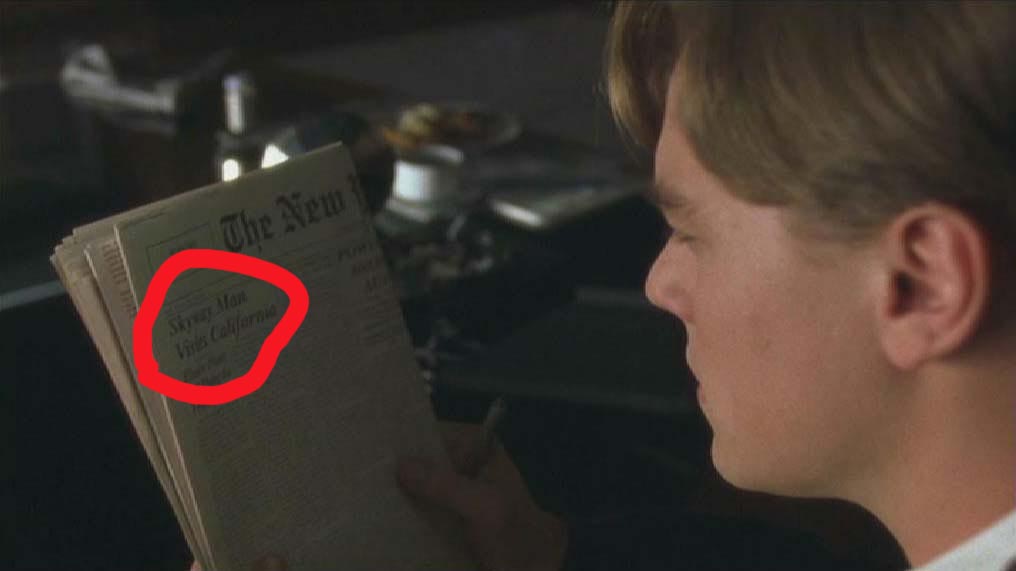
Scene 11 — 55:09
Abagnale himself puts it like this:
“I had enjoyed a misguided
and regrettable run as one of the most
successful con artists the world has ever
known. [...] The New
York Times, in its coverage, referred to
me as ‘The Great
Impostor’.” (book
“The Art of the Steal”, page
6)
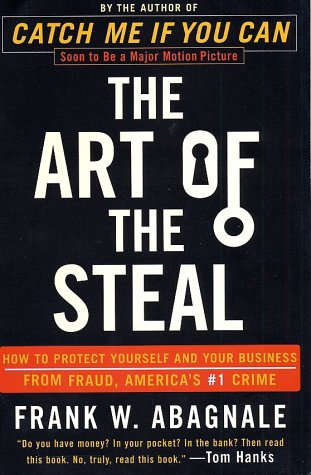
Frank W. Abagnale
“The Art of the Steal”
How to Protect Yourself and Your Business from Fraud, America’s #1 Crime
Broadway Books, 2001
ISBN 0767906845
In his book
“Stealing Your Life”,
he calls his criminal career a
“foolish teenage infatuation
with perpetuating swindles”
(page 12).
Or still: “My
escape
[from an Atlanta prison] made
the front page of one New York paper,
‘Frank Abagnale, known to police the
world over [...] and
who once flushed himself down an airline
toilet to elude officers, is at large
again…’ the story
commenced.” (book
“Catch Me If You Can”, page 204)
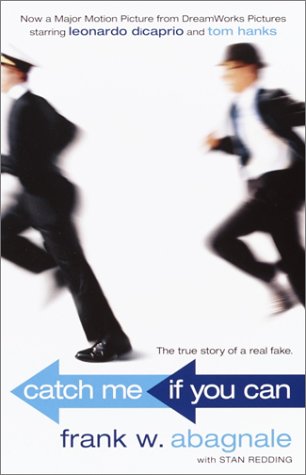
Frank W. Abagnale (with Stan Redding)
“Catch Me If You Can”
Mainstream Publishing, 2003
ISBN 1840187166
The former police chief of Houston
once said of me: “Frank Abagnale
could write a check on toilet paper,
drawn on the Confederate States Treasury,
sign it
‘U.R.
Hooked’ and cash it at any bank in
town, using a Hong Kong driver’s
licence for
identification.” (book
“Catch Me If You Can”, page
91)
(Nowadays, some banks require all
non-customers — people that
don’t have an account with them
— that come in to cash a check to
leave their fingerprints in ink on the
check. When somebody objects, the teller
does not accept the check. According to
F.B.I.
statistics, this single security measure
reduces check fraud instantly by
50%!)
Some extra info is found in
Abagnale’s white paper “Check
Fraud and Identity Theft, Volume
III” (2004) (page 2): “I
had 50 legitimate driver’s
licences.”
In the interview included in the 2003
edition of the book, Abagnale claims about
80% of the movie is accurate (book
“Catch Me If You Can”, page
214). In his foreword to
“Catch Me If You Can — The Complete Screenplay”
(page 8), he goes even further:
“[...]
90% of the film is
accurate. [...] the
movie really captures my essence of the
story.”
Notice the movie’s
tagline,
“The true story of a real fake”!
Fast rewind
The Float
As a check forger, Frank
Abagnale was an absolute master and a true
innovator: he was the first forger to
exploit the routing of checks as indicated
through numbers on the
codeline.
This type of fraud is now called
“the float”.
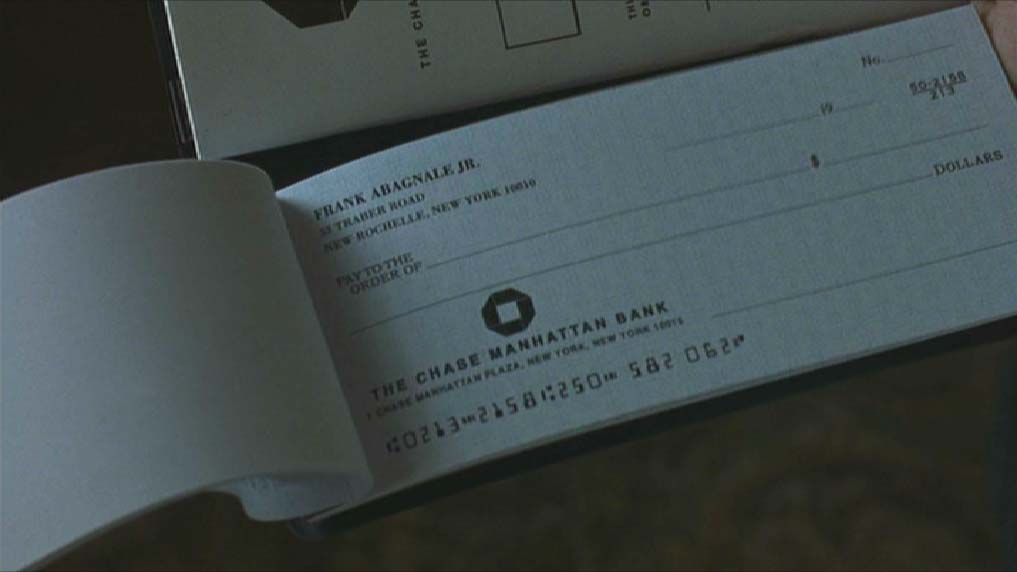
Scene 3 — 17:40
Says Abagnale: “What landed me
in jail was my other habit, which was my
enthusiasm for passing bad checks. The main
reason I adopted those guises was to give
me credibility when I cashed hot checks
— and to satisfy my great taste for
women. Hotel clerks and merchants
didn’t question pilots and doctors
too closely. Through my various hustles, I
passed something like
$2.5 million
worth of checks, a blizzard of paper that I
scattered in earnest throughout all fifty
states and twenty-six countries, all before
I was legally allowed to drink.
[The
legal drinking age
in the
U.S. is
21.] I was proficient enough at
cashing fraudulent checks that I earned the
distinction of becoming one of the
most hunted criminals
by the
F.B.I.”
(book “The Art of the Steal”,
page 6).
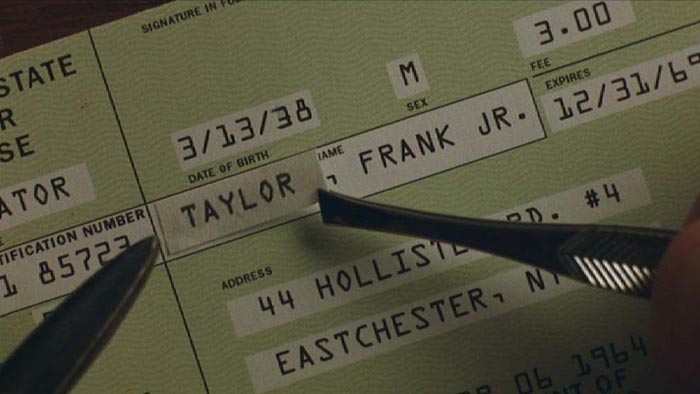
Scene 6 — 29:18
Abagnale used a number of
aliases
— he reportedly used 8 identities,
basically variations such as Frank Adams,
Dr. Frank
Conners, Frank Williams, Robert
Black, Robert Conrad and Robert Monjo.
In the movie, he uses the aliases Frank
Black, Frank Roberts and Frank Taylor.
(Incidentally, Frank Taylor is also the
name of the first pilot to get off the
spaceship in
“Close Encounters of the Third Kind”!)
For instance, during Abagnale’s
aborted engagement party —
he’s known to the family as
Dr. Conners
—, he admits to his fiancée
Brenda Strong that he uses the aliases
Frank Black and Frank Taylor when
he’s traveling (scene 16, 1:36:12).
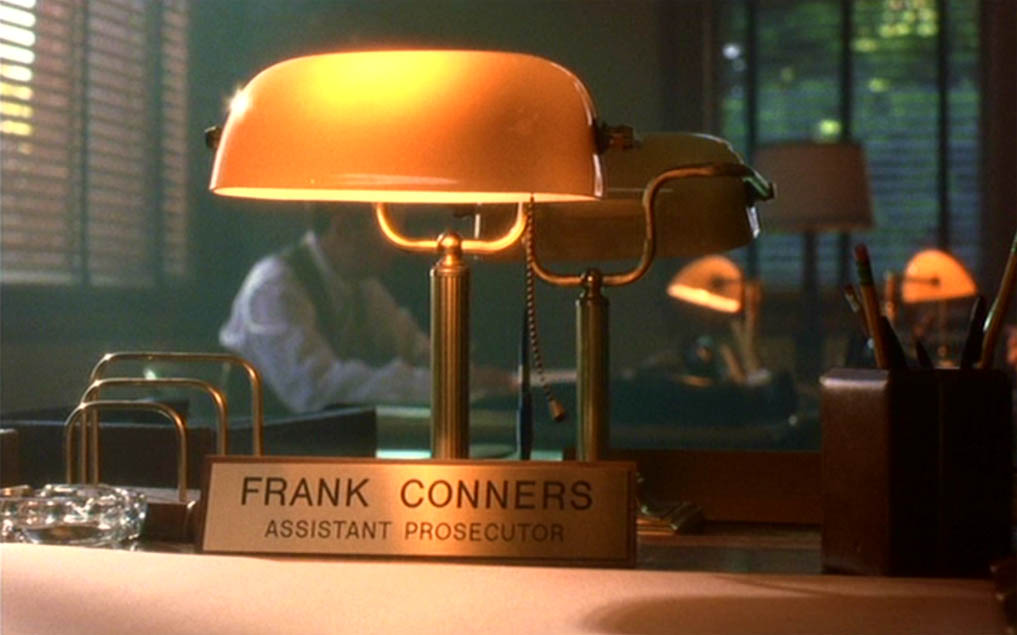
Scene 14 — 1:25:47
Fast rewind
The Basics: To Tell the Truth… on TV
In 1977, Abagnale appears on a
TV
show called “To Tell the
Truth” to tell his amazing story. This
TV quiz has a
simple formula: three friends play the same
character, people have to guess which of the
three is for real.
Abagnale did appear on that program,
here‘s the picture (signed by Abagnale!)
that proves it. He’s the pilot in the
middle. Here, one “impostor” is
dressed as
doctor,
the second as
pilot
and the third as
inmate.)
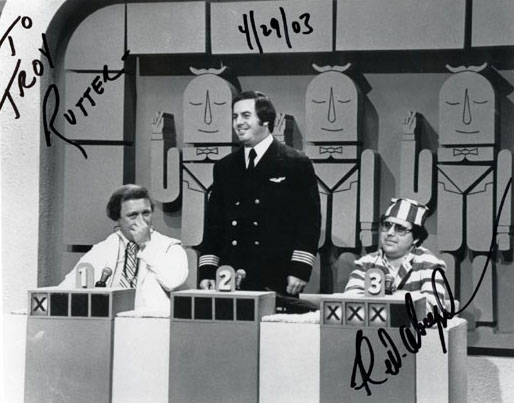
Not only that, Abagnale decided to write up
a book about his life after
he’d gone on another
TV show,
the famous “Tonight Show” with
Johnny Carson (later presented by Jay Leno and
now by Jimmy Fallon). His segment was scheduled
for six minutes, but went on for 20! The next
day, hundreds of people called the broadcasting
company to ask where they could buy the book.
There wasn’t any book to buy, but the
many reactions gave Abagnale the idea to write
one. (He could use the money because he
was getting
married
at the time…)
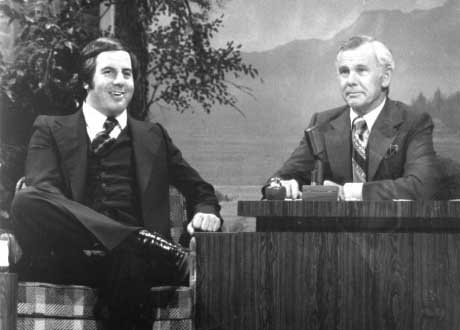
The book came out
in 1980 with help from ghost
writer
Stan Redding
and turned out to be a real success. Redding
interviewed Abagnale for 4 days, 8 hours a day,
then wrote the book on his own. A
Houston Chronicle
journalist, he
also covered the low-key burial of
JFK
assassin
Lee Harvey Oswald
at the Rose Hill Cemetery in Forth Worth. Lacking
pallbearers, seven reporters stepped in to carry
Oswald’s coffin. (The
F.B.I.
agent that caught Frank Abagnale —
he’s called
Carl Hanratty
in the movie but we reveal his true identity
— spent a few days investigating the
JFK
murder in Chicago.)
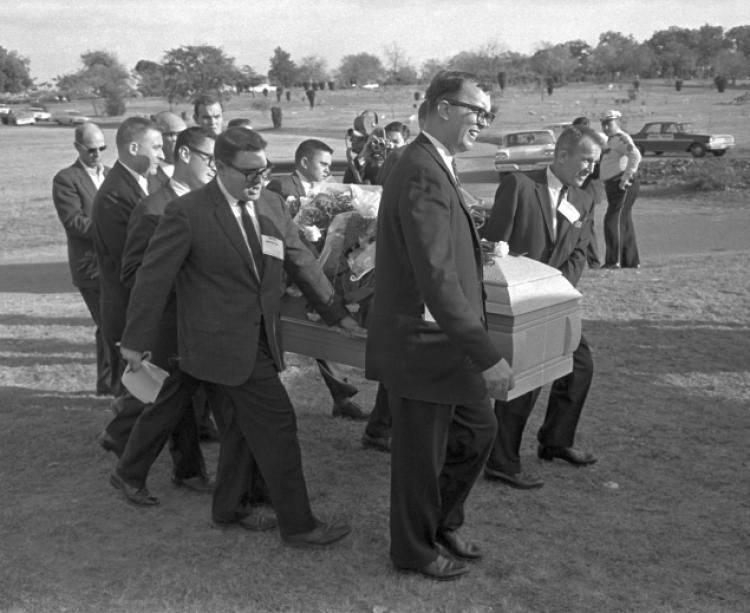
Abagnale’s autobiography is regularly
reprinted and available in some 30 languages.
The movie rights were sold instantly, but
it’s only some 20 years down the road
that Spielberg got involved.
(After Spielberg’s movie grossed $352
million world-wide in movie theatres, a
TV series
and an eponymous
musical
followed.)
Fast rewind
Frame Freeze: The Odyssey of a Movie
Abagnale has written the foreword of the book
“Catch Me If You Can — the
Complete Screenplay”.
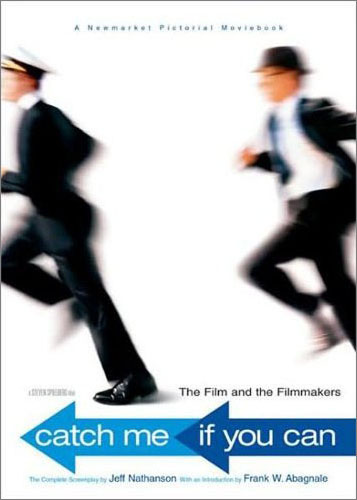
Jeff Nathanson
“Catch Me If You Can”
the complete screenplay with an introduction by Frank W. Abagnale
Newmarket Press, 2003
ISBN 1557045534
He provides lots of details in it on the
tumultuous journey of the movie rights
(page 7-13). Quoting pages and pages from
a book exceeds “fair use” of
source material, but let me summarize the
journey of the movie:
- Soon after his
TV
appearance, Hollywood showed interest in
his story. He entered into a agreement
— an option contract — with
Bud Yorkin in 1978. After two years, Bud
Yorkin told him he was no longer
interested.
- The next years, Columbia
TV and
Grosso-Jacobson optioned the movie rights.
- Hall Bartlett optioned the movie
rights in 1986 for four years. Tom Cruise,
Eddie Murphy and David Hasselhoff were
considered for the part.
- After four years, Abagnale hoped to
see the movie rights returned to him,
but Bartlett paid the full purchase price
($250,000) for the movie rights. At
this point, Abagnale lost all control and
rights over the movie.
-
In 1990, an independant producer Michel
Shane, bought the rights from Bartlett
for $300,000. He optioned the movie
to Hollywood Pictures, a division of
Disney, who returned the rights to Shane
after two years.
-
During the 1980s, the Coen brothers
considered the project.
-
In 1994, Sony Tri-Star optioned the
rights for one year.
-
In 1996, Barry Kemp and Bungalow 78
optioned the rights for two years.
-
It was Barry Kemp and his associate
Devorah Moos-Hankin that took the
project to
Walter Parkes
and
Laurie McDonald,
Spielberg’s producers at
SKG Dreamworks,
then still a starting film studio.
Halleluyah! (Moos-Hankin is credited
as co-producer, Kemp as executive
producer.)
Fast rewind
Michael Sabo: A Sidetrack
One element isn’t mentioned in
this summary: according to some sources,
Spielberg also considered another
fraudster turned
legitimate,
Michael Sabo,
to base the movie on his life.
Which certainly was an option: Sabo was
a check, bond and stock forger, he
impersonated airline pilots with 6
carriers —
Allegheny Airlines
(later acquired by
US
Airways),
American Airlines,
Delta Air Lines,
TWA
(now part of American Airlines),
United Airlines
and
US Airways)
(now merged with American Airlines),
— but, unlike Abagnale, took
control of an Boeing 727 in flight.





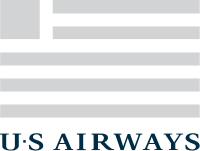
He impersonated a doctor but, unlike
Abagnale, took the risk of performing
medical acts, handling the delivery of
a baby. He posed as a
Ph.D.
and had over 100 different identities in
total. To answer the next question: did
he go on
TV? He
impersonated a doctor on a national
TV
program, “Unsolved
Mysteries”.
Sounds familiar already? He escaped
from federal prison and stole over
$10 million! And he blames… his
parents for his criminal career: he
feels his father’s rejection
caused him to take a wrong turn. (On
his web site, he claims he went
criminal in desparation to cover the
medical bills of a girlfriend with
breast cancer but without health
insurance.) After 12 years in jail,
he became the founder and
executive director
of
Prison Consultants of America,
a consultancy firm for
white-collar crime.

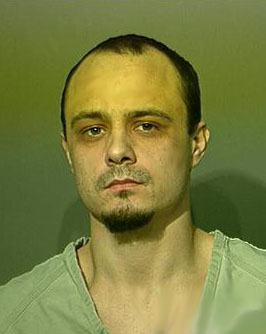
Sabo lecures and consults on identity
theft, fraud
etc. —
same thing as Abagnale — but he
mainly assists (first-time) white-collar,
drugs and sex offenders to
“navigate the complex prision
system” as he puts it on his
web site. And I don’t see Abagnale
doing that ever!
Elsewhere on his web site, you get the
unvarnished truth: “Without
understanding prison life, you could risk
a 25-30% chance of getting killed, a
10-15% change of getting raped, a
30-40% chance of getting stabbed, a
80-90% chance of getting
beaten.” If we can avoid the
knee-jerk reaction that they all deserve
it anyway, this says a lot about the
American prison system —
The Shawshank Redemption,
anyone? — and — once more
— Frank Abagnale this is not.
Spielberg saw the score and quickly made
the right choice. As for Michael Sabo, he
was scamming from
the 60s well
into the
90s.
(Abagnale’s criminal career was over
at the age of 21.) Sabo was a fugitive on
the run when he should have seen the error
of his ways and been available to sign a
movie contract…
Fast rewind
Truth or Fiction?
Scene 1 gives this info on Frank Abagnale.
-
Committed financial crimes from from ’64
to ’67.
There’s a
continuity error
in the movie: according to
scene 20,
he was arrested on March 3, 1970.
All these dates are wrong, actually!
-
Impersonated an airline pilot, a doctor
(chief resident pediatrician) and an
assistant
D.A.
As a pilot, he flew over two million miles
for free.
Abagnale summed it up succintly in his
foreword to “The Art of the Con”,
the book of another fraud expert, R. Paul
Wilson (Lyons Press, 2014):
“For five years, I lived as
an impostor. I pretended to be a
pilot,
a doctor,
a teacher, a
lawyer,
and a
peace officer.”
-
Cashed bouncing checks in all 50 U.S.
states and 26 foreign countries.
-
Stole “almost” $4 million
with fraudulent checks. The real figure
was $2.5 million. (According to
Abagnale’s own estimate, he wrote
some 17,000 bad checks!)
Note that we’re talking about
greenbacks from the
60s here,
not the inflated dollar of today!
We have a second continuity error here: when
F.B.I.
agent Hanratty
and Abagnale speak over the phone on
Christmas Eve in scene 15, the figure of
“almost” $4 million is
repeated. The problem is that Abagnale only
gets caught on Christmas Eve… of a later
year! How can the end total be “almost
$4 million” (scene 1, 3:47) when
the intermediate score with Abagnale in
Louisiana — at least 1 year before his
arrest
in France — already reaches the same
amount (scene 20, 1:33:05)? And during that
extra year, he tours around the world and
gets caught in France… printing
“real” fake checks on a
Heidelberg.
Here’s what Carl Hanratty has to say
about this period: “The
kid’s gone completely out of
control
[...]” (scene 18,
1:45:25) with checks from South America,
Australia, Singapore, Egypt and Spain.
(Just don’t blame the actors for the
mix-up! The mistake is right there in the
screenplay
(on page 20 and 112).)
-
Did it all before his 19th
birthday.
More poetic liberty here: he did it
from the age 16 to 21. Abagnale was born on
April 27 1948.
None of which makes Abagnale a modern
Robin Hood,
as some naively think. Abagnale did not
rob the rich — he stole from large
companies, mainly banks, not the same
thing! — and he certainly never
distributed his loot among the poor. This
is true: he did not steal from mom
and pop stores and he never committed
violence, it was all guile and cunning
from a gentleman criminal!
He could do this because, as a kid, he
looked 10 years older than he was. Says
Abagnale: “It had always
surprised people, especially women, to
learn that I was still a
teenager.” (book “Catch
Me If You Can”, page 24) Here he is
at the age of 16…
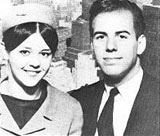
(Let me talk some more about
film technique
in passing: when agent Hanratty recognizes
Frank Abagnale in a school yearbook (scene
12), Spielberg and his editor
Michael Kahn
make use of multiple
jump cuts
— a favorite style figure of
Spielberg!)
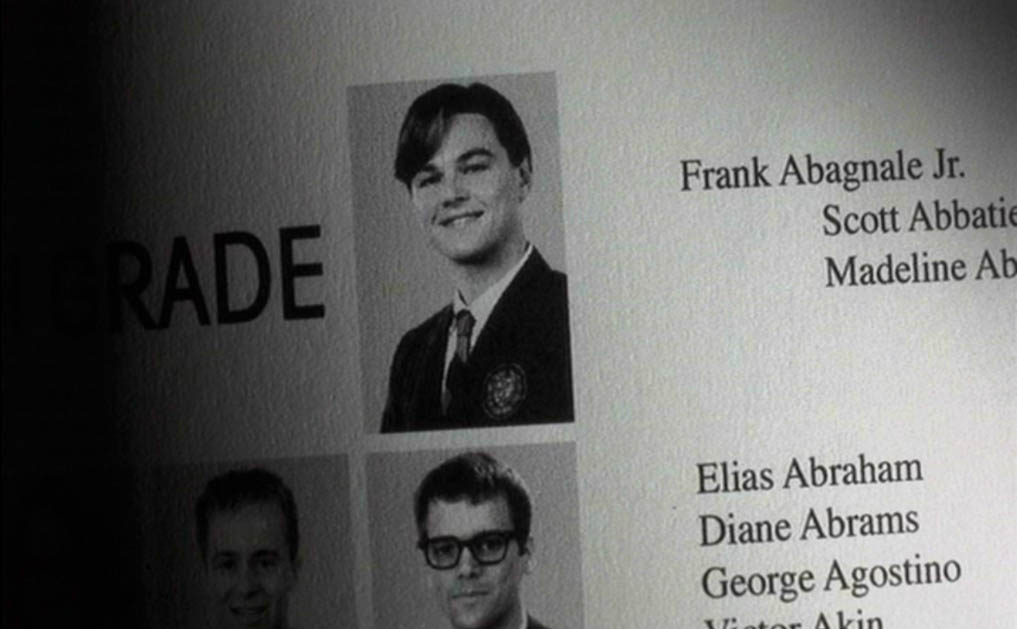
Scene 12 — 1:06:39
His fourth career was left out of the
movie because of time constraints and
because it didn’t add any new
elements. Indeed, Abagnale also handled a
summer course as a
sociology professor
at the
Brigham Young University
in Utah. He was very well liked by his
students, although he just read one chapter
ahead of them every week. Having read in a
local paper that Brigham Young was looking
for sociology instructors, he forged a
transcript
(diploma) from the
Columbia University
(New York) for his interview with the dean.
(book “Catch Me If You Can”,
page 86)
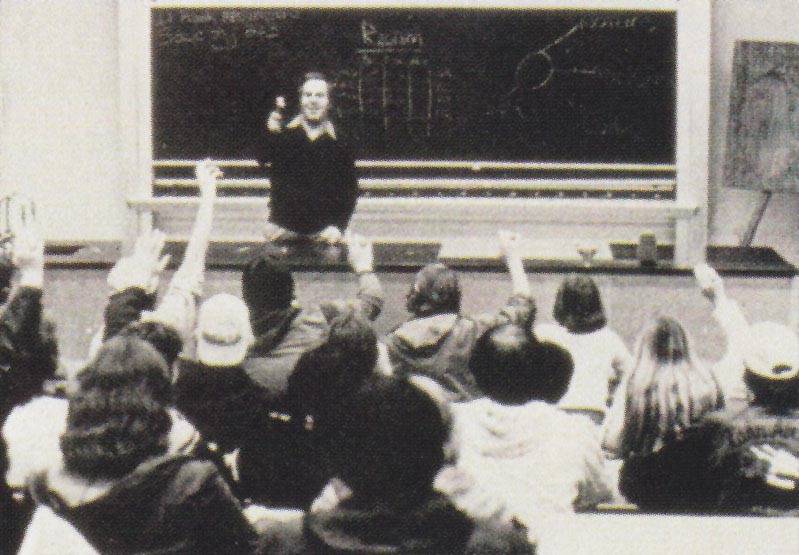
Fast rewind
When the truth becomes fiction, the con is a con…
OK. That’s the Frank Abagnale story
as we know it from the movie, his
autobiography,
his interviews and public talks
etc. But
things took a dramatic turn when the Irish
historian
Alan C. Logan’s
had a close look at Abagnale’s life
and published his findings in 2020, 18
years after the film’s
première. A very close look.
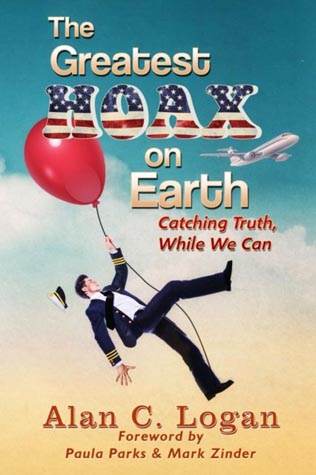
Alan C. Logan
“The Greatest Hoax on Earth – Catching Truth, While We Can”
Alan C. Logan, 2020
ISBN 1736197401
Drumrolls: Abagnale is not who he claims to
be. As a youth, he was a criminal
alright… but a small-time crook at
best. Take away the glamour, the
pilot
mileage, the high-profile
F.B.I.
team that chased him. Logan speaks of
“all foam, no beer, all icing,
no cake.” (The Greatest Hoax
on Earth, page 319)
He was
arrested
several times — by local police! Nor
was he an “ethical thief”, a
Robin Hood
figure who only stole from large
corporations, mainly banks. This book
contains testimonies of small shop owners
and private families that got ripped off.
His former booking agent, Mark Zinder, the
man who ultimately got Abagnale a spot on
Johnny Carson’s show
and who took the photos of Abagnale in
professional attire (with facial hair
from the late
70s,
not from the
60s), wrote
a foreword.
“The real events […]
mean that between the ages of sixteen
and twenty, Abagnhale had virtually no
opportunity to do laps around the globe
with
Pan Am,
or any other airline, and become a
millionaire writing bad
checks.
The
F.B.I.
was not chasing him. He wasn’t
working for nearly three years as a
doctor,
lawyer and
professor.
[…] Essentially, Frank
W. Abagnale
was, for the most part, behind
bars.” (The Greatest Hoax on
Earth, page 289)
Logan’s book was meticulously
researched; he provides plenty of
police reports, mug shots
etc. to
debunk the stylish master criminal.
Then again, Abagnale locked up the
spiffy fraudster franchise
conclusively, and you shouldn’t
expect him to respond to Logan’s
book ever. Way too much is at stake for
him.
More importantly, Spielberg’s
movie was released in December 2002
and is therefore based on information
available then. That also applies
to this web site. It showcases how
a book gets turned into a movie. Which
material (available then) was dropped
and altered to compress the con man
story into a 2h
21m film?
Which creative decisions turned that
story, now proven false, into a fine
Spielberg movie with
John Williams
music and
Janusz Kaminski photography?
Fast rewind
Submit feedback
























